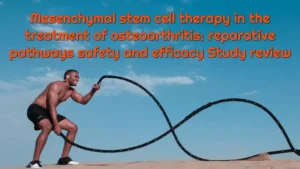This 5 year study of stem cells for heart regeneration published in the European Heart Journal, Volume 41, Issue Supplement_2, November 2020, ehaa946.1719, https://doi.org/10.1093/ehjci/ehaa946.1719 shows that umbilical mesenchymal stem cells work for improving left ventricle ejection fraction.
This was not the biggest study with only 10 participants, but the results are still amazing. Of the 10 patients that received 30 million mesenchymal stem cells for their heart issues, all of the participants saw left ventricle ejection fraction improve. The study followed up for 5 years and found that results peaked at 1 year post treatment. Those results then remained all the way to the 5th year of follow up. This means that the regeneration of the heart was lasting and not a temporary fix. This sounds simple, but it is an incredible find. No other treatment available at this time has been shown to improve ejection fraction and maintain those results. There are plenty of medications that help treat the symptoms and they don’t even do a very good job at that. The stem cells are creating real heart health improvement. No adverse effects were reported from the stem cell treatments either. All together this is solid evidence that mesenchymal stem cells are a great option for congestive heart failure and other issues relating to lowered ejection fraction.

Abstract
Introduction
CIRCULATE-Acute Myocardial Infarction is a double-blind controlled trial randomizing (RCT) in 105 consecutive patients with their first, large AMI (cMRI-LVEF ≤45% and/or cMRI-infarct size ≥10% of LV) with successful infarct-related artery (IRA) primary percutaneous coronary intervention (pPCI) to transcoronary administration of Wharton’s Jelly Mesenchymal Stem Cells (WJMSCs) vs. placebo (2:1). The pilot study cohort (PSC) preceded the RCT.
Aim
To evaluate WJMSCs long-term safety, and evolution of left-ventricular (LV) function in CIRCULATE-AMI PSC.
Material and methods
30 000 000 WJMSCs (50% labelled with 99mTc-exametazime) were administered via IRA in a ten-patient PCS (age 32–65 years, peak hs-Troponin T 17.3±9.1ng/mL and peak CK-MB 533±89U/L, cMRI-LVEF 40.3±2.7% and infarct size 20.1±2.8%) at ≈5–7 days after AMI using a cell delivery-dedicated, coronary-non-occlusive method. Other treatments were per guidelines.
WJMSCs showed an unprecedented high myocardial uptake (30.2±5.3%; 95% CI 26.9–33.5%), corresponding to ≈9×10 000 000 cells retention in the infarct zone – in absence of epicardial flow or myocardial perfusion impairment (TIMI-3 in all; cTFC 45±8 vs. 44±9, p=0.51) or any hs-Troponin T elevation. Five-year follow up included cardiac Magnetic Resonance Imaging (cMRI) (at baseline, 1 year and 3 years) and detailed echocardiography (echo) at baseline, 1 year, 3 years and 5 years.
Results
By 5 years, one patient died from a new, non-index territory AMI. There were no other cardiovascular events and MACCE that might be related to WJMSCs transplantation.
On echo (Fig), there was an increase in left ventricular ejection fraction (LVEF) between WJMSCs administration point and 1 year (37.7±2.9% vs. 48.3±2.5%, p=0.002) that was sustained at 3 years (47.2±2.6%, p=0.005 vs. baseline) and at 5 years: (44.7±3.2%, p=0.039 vs. baseline). LVEF reached a peak at 1 year after the AMI and WJMSCs transfer (Fig). cMRI data (obtained up to 3 years; 1 year 41.9±2.6% vs. 51.0±3.3%, p<0.01; 3 years 52.2±4.0%, p<0.01 vs. baseline) were consistent with the echo LVEF assessment.
Conclusions
5-year follow up in CIRCULATE-AMI PSC indicates that WJMSC transcoronary application is safe and may be associated with an LVEF improvement. The magnitude of LV increase appears to peak at 1 year, suggesting a potential role for repeated WJMSCs administration(s). Currently running double-blind RCT will provide placebo-controlled insights into the WJMSCs effect(s) on changes in LV function, remodelling, scar reduction and clinical outcomes.

Echo-LVEF evolution
Funding Acknowledgement
Type of funding source: Public grant(s) – National budget only. Main funding source(s): STRATEGMED 265761 “CIRCULATE” National Centre for Research and Development/Poland/ZDS/00564 Jagiellonian University Medical College



